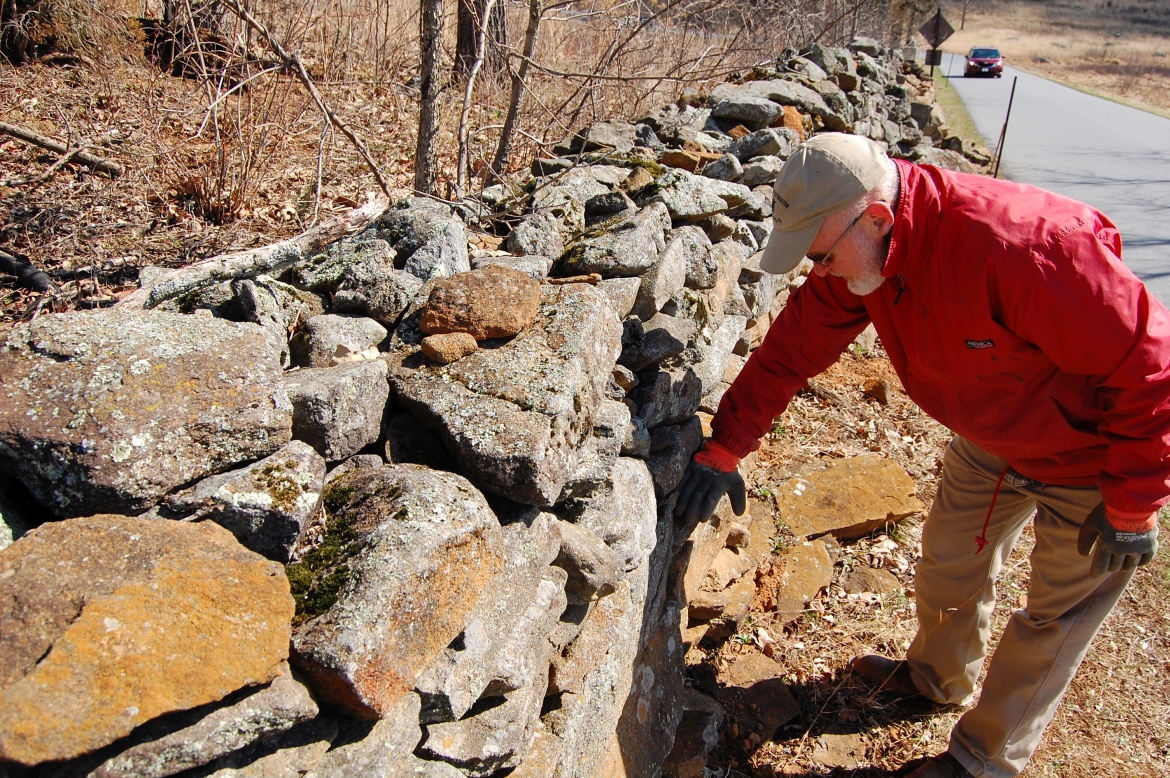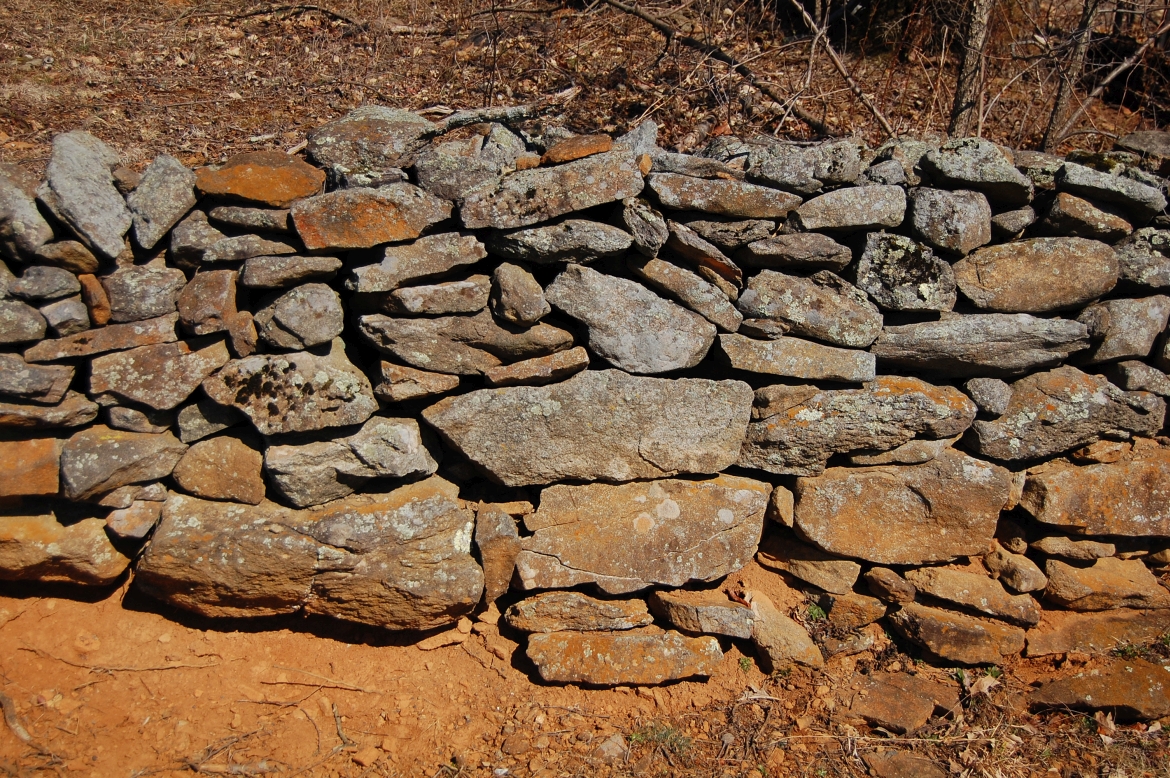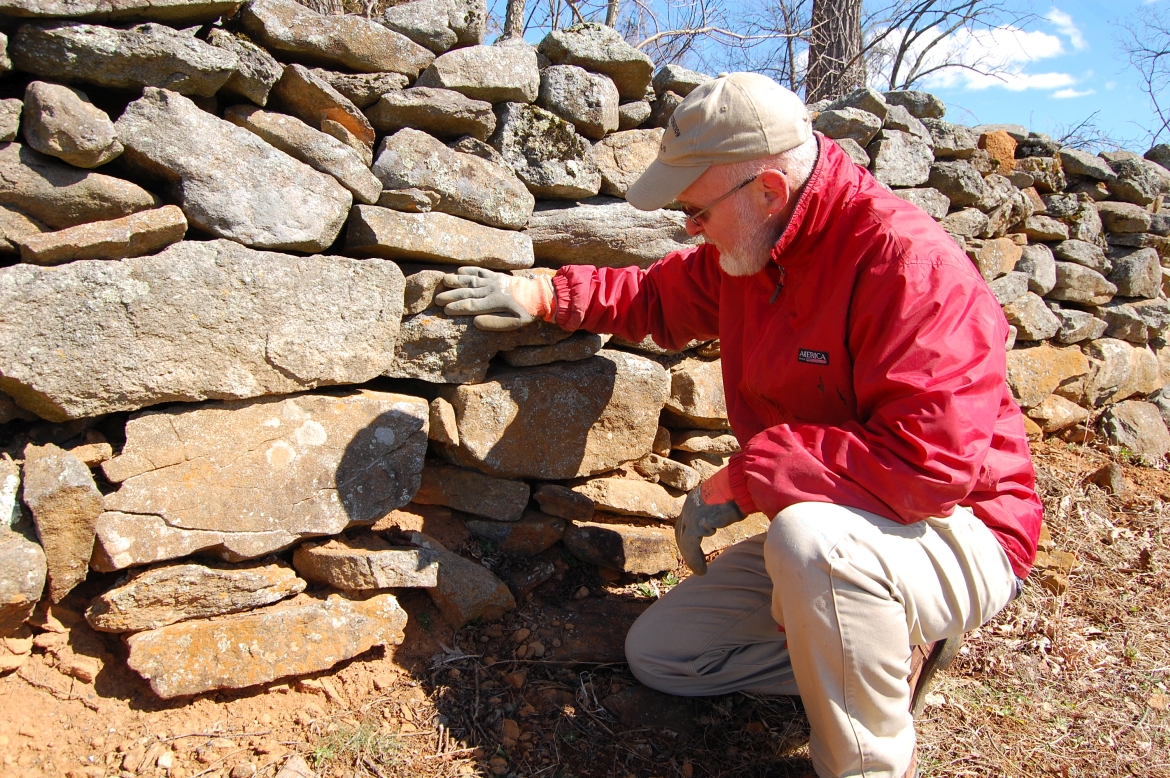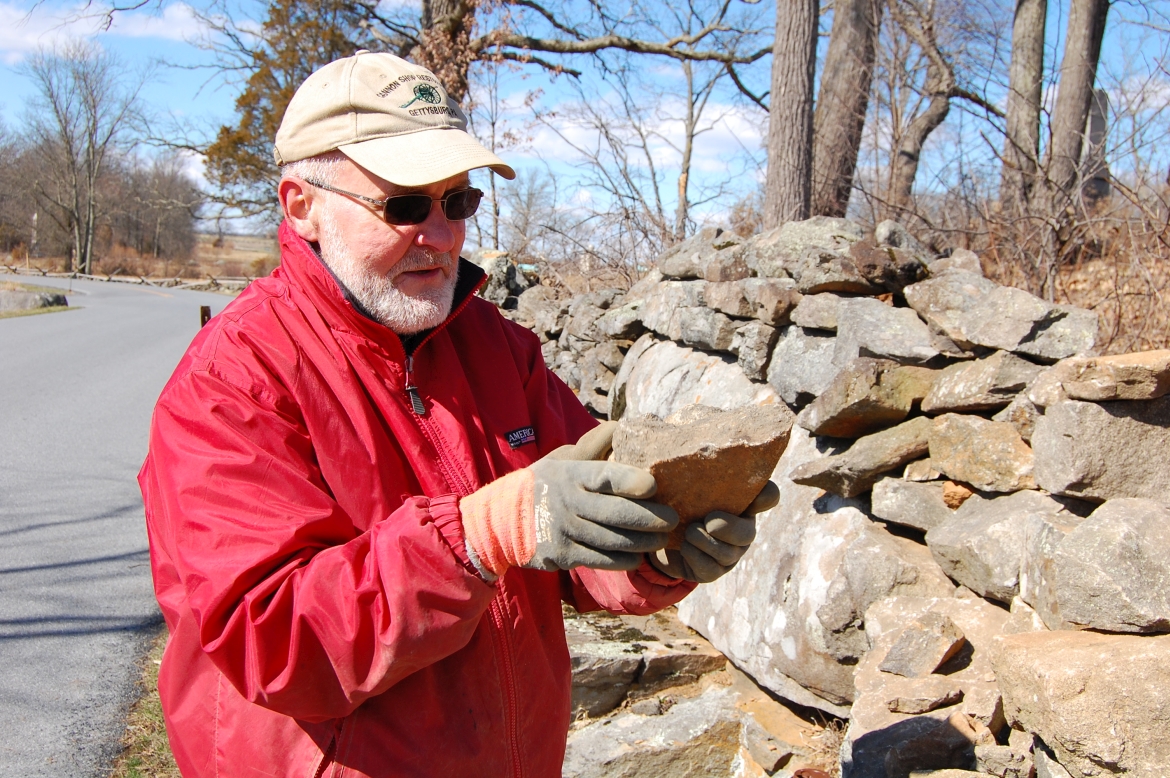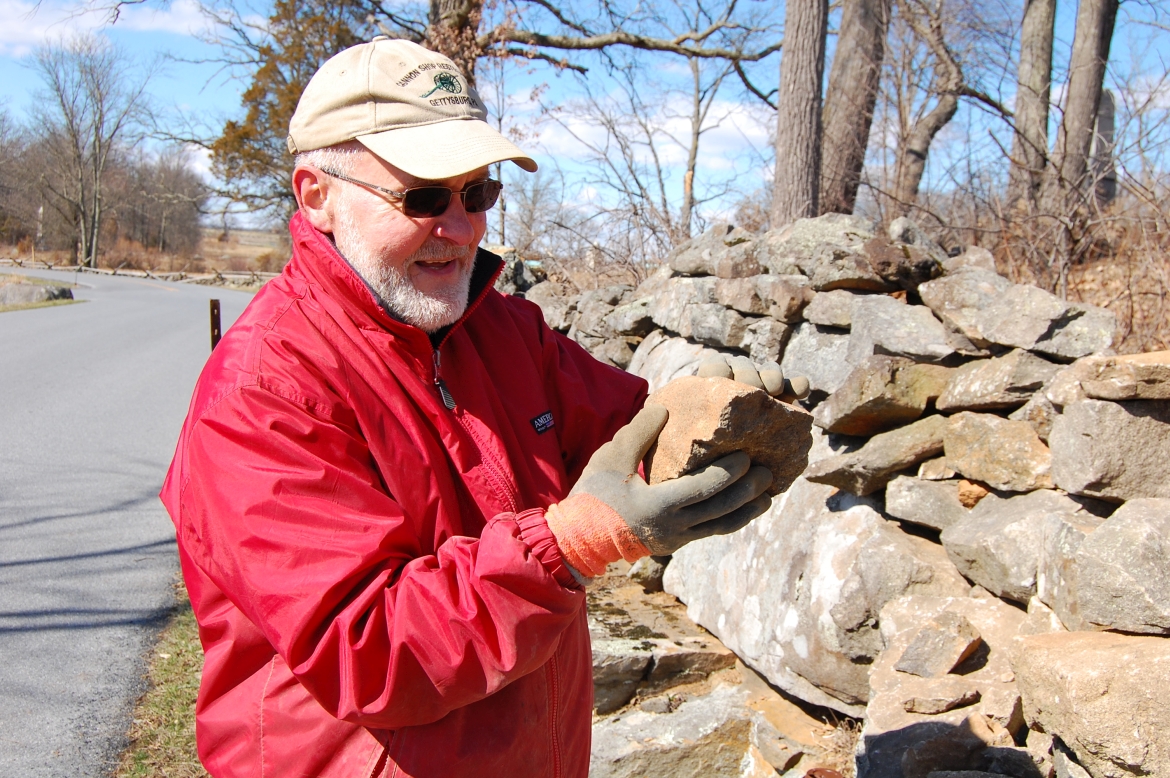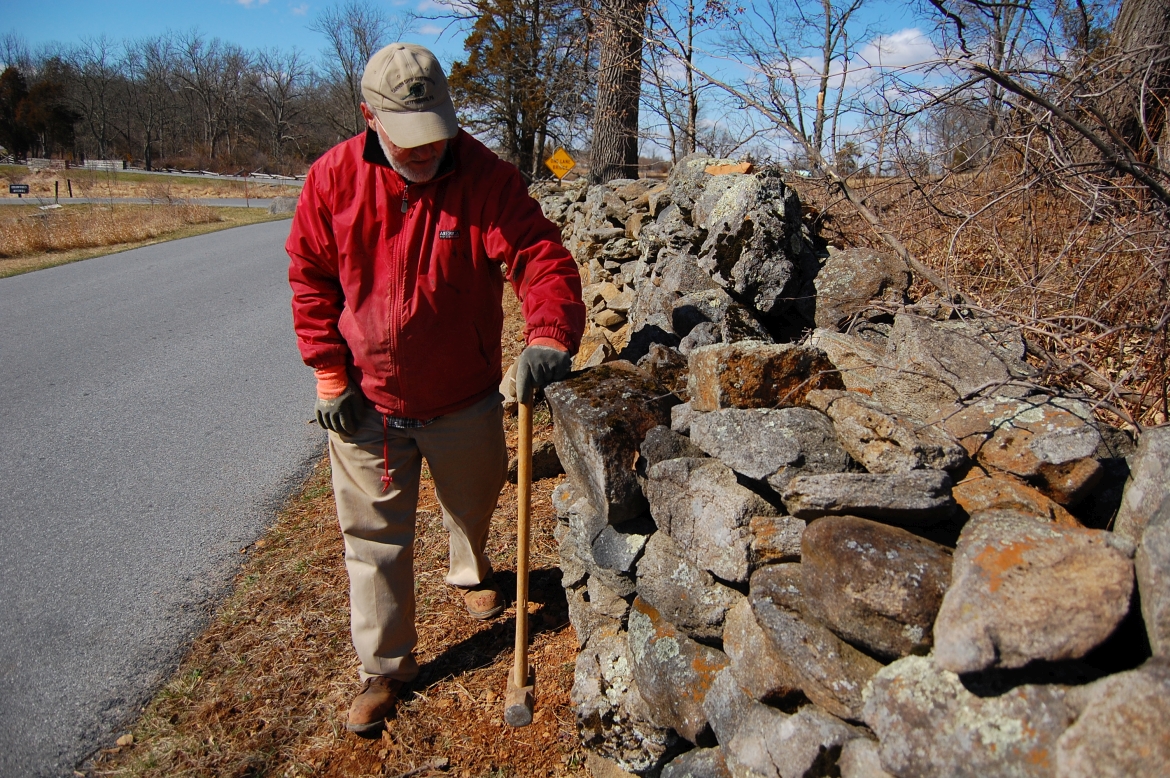Bob Resig has volunteered at Gettysburg National Military Park for almost twenty years. Today he’s rebuilding a wall along the Wheatfield Road.This view was taken facing southeast at approximately 2:00 PM on Saturday, March 11, 2017.
We ran into Bob while he was working Saturday afternoon. This particular wall has bothered him for a long time.Little Round Top is in the right background. This view was taken facing southeast at approximately 2:00 PM on Saturday, March 11, 2017.
Because it was built next to a rise of ground (right), the wall has been tipping toward the roadway. Bob has rebuilt or worked on a number of walls in the park over the years, but he was excited to have the opportunity to tackle this one.This view was taken facing northwest at approximately 2:00 PM on Saturday, March 11, 2017.
Bob’s showing us the approximate height of the ground on the other side of the wall. “The downhill slope with weight behind it is bad. There needs to be a gradual downhill creep,” Bob told us.This view was taken facing southeast at approximately 2:00 PM on Saturday, March 11, 2017.
“These are solid walls considering the abuse they’ve taken. Even though it’s not a historic wall soldiers would have used during the battle, it’s lasted probably 80 years.”This view was taken facing northeast at approximately 2:00 PM on Saturday, March 11, 2017.
A number of the stones are pushing outward from the wall. For Bob this is a bad sign. It means the wall isn’t as structurally sound as it should be. “When I took the endstone off to rebuild this wall the whole thing just went. At first I thought I could patch this wall, but I have to rebuild it so it’s solid. It’s like a house. If the house is leaning, you have to go to the foundation to fix it. Ground up.”This view was taken facing north at approximately 2:00 PM on Saturday, March 11, 2017.
A current resident of Hanover, Pennsylvania, Bob first became enamored with the Gettysburg area when he moved here for a job in 1996. “It’s interesting. To the best of my knowledge, this would have been some kind of a fence during the battle. But they must have decided this hillside needed shoring up and placed a stone wall.” Where do you begin with a wall like this? You take each unsound section apart and start over. Here Bob shows us how he has to get these two sections of wall to stretch across and meet each other.This view was taken facing northwest at approximately 2:00 PM on Saturday, March 11, 2017.
But which stone fits best? “I pick a stone and then I usually visualize, turning it each direction in my mind to see if it’s a good candidate.”Houck’s Ridge is the rise of ground in the background. This view was taken facing southwest at approximately 2:00 PM on Saturday, March 11, 2017.
There’s a meditative and patient quality to Bob’s work. We watched him pick up and replace stones, pausing after each placement or adjustment to assess. Then pick up, replace, and adjust again.This view was taken facing south at approximately 2:00 PM on Saturday, March 11, 2017.
Should it be this way? It’s not bad…This view was taken facing south at approximately 2:00 PM on Saturday, March 11, 2017.
There it is!This view was taken facing south at approximately 2:00 PM on Saturday, March 11, 2017.
Bob points out another section up the road that fell on its own. “I don’t want to see anyone get hurt. There are a lot of moms pushing strollers and bike riders that come through here.”The 3rd Massachusetts Battery is in the right background. This view was taken facing northwest at approximately 2:00 PM on Saturday, March 11, 2017.
We didn’t know what a “plumb line” was, but Bob explained it to us. The weight of his mallet-head demonstrates a vertical line from the surface below. “Now look at the wall. See?” The wall should not be leaning out towards the roadway.This view was taken facing northwest at approximately 2:00 PM on Saturday, March 11, 2017.
Another thing Bob taught us about was packing. The interior of the wall needs to be packed tightly with stones. Smaller stones have to be wedged in between larger ones to provide stability. “It shouldn’t wobble.” If there are gaps and pockets inside, rodents can make a home in the wall. “Over time, if there are voids in the wall soil can wash down in there. I shouldn’t be able to do this,” Bob said, reaching his arm through a pocket in the wall.This view was taken facing west at approximately 2:00 PM on Saturday, March 11, 2017.
Because the only stones to work with are from this wall, Bob has climbed up the hill a few times to scavenge for small stones to pack it with.This view was taken facing southwest at approximately 2:00 PM on Saturday, March 11, 2017.
Noticing a mark in this boulder where a drill bit had been, Bob placed his mallet to mark it. This boulder would have been reduced in size when the Wheatfield Road was paved.This view was taken facing east at approximately 2:00 PM on Saturday, March 11, 2017.
He also showed us quarry marks and reminded us about the pins and feather quarrying method that would have been used on these stones. Where did Bob learn all this? “I learned more on YouTube in a day than I would have reading books about this stuff. The internet is really a wonderful thing.”This view was taken facing north at approximately 2:00 PM on Saturday, March 11, 2017.
Bob received a majority of his training in stone wall building from the National Park Service employees he’s worked with. “They’re all master stone masons. I’ve just picked a lot of this up over the years. I love it.” He hopes more people will volunteer to help out with projects like this at the park. The park service recently announced that it is recruiting and training additional volunteers to assist with visitor services this spring and summer. Training will be offered on the afternoon of March 24th. Interested candidates should contact the park’s excellent Visitor Services Volunteer Coordinator, Barb Sanders, by emailing [email protected] or by calling (717) 338-4422.This view was taken facing south at approximately 2:00 PM on Saturday, March 11, 2017.




